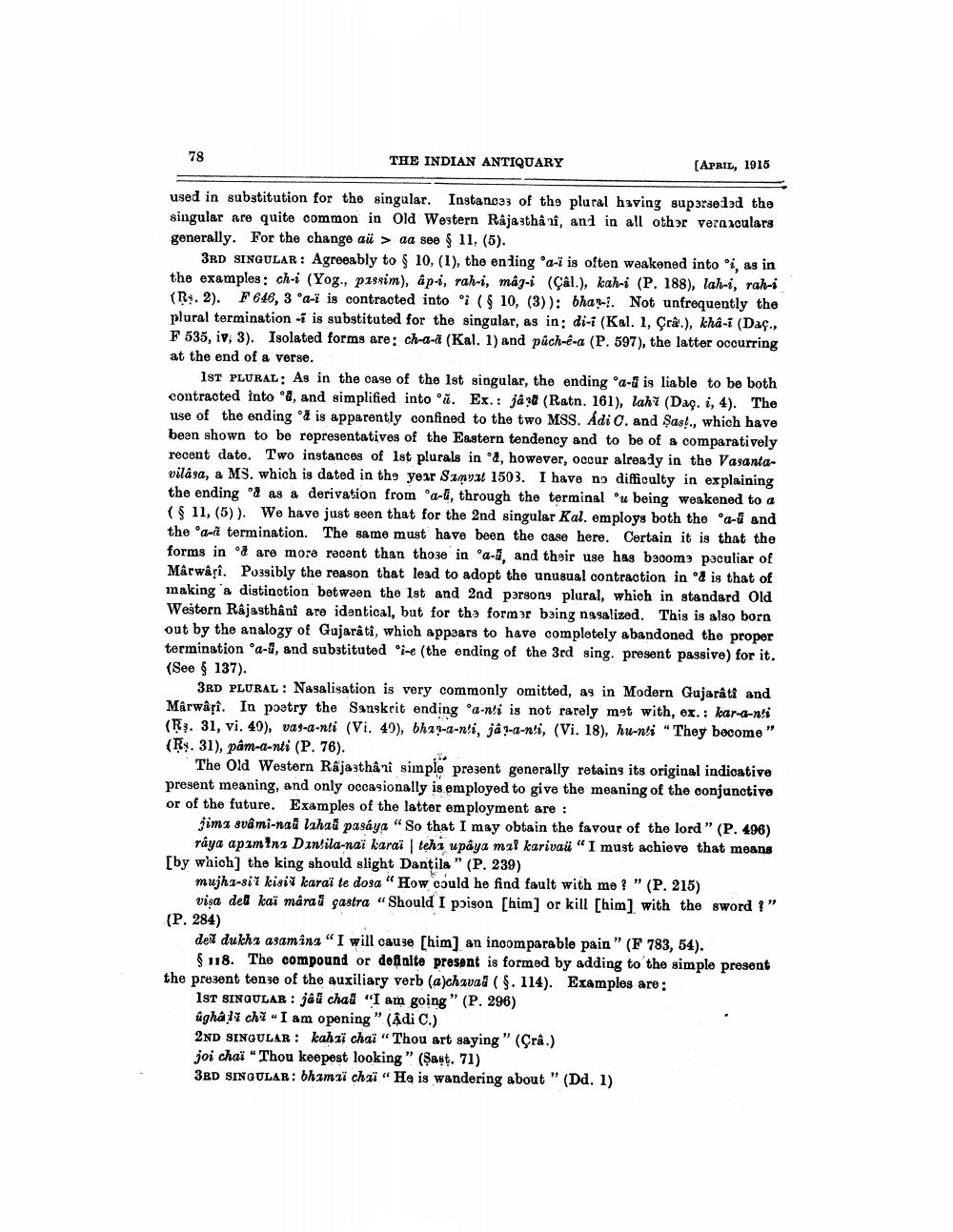________________
78
THE INDIAN ANTIQUARY
[APRIL, 1915
used in substitution for the singalar. Instances of the plural having supsrse 19d the singular are quite common in Old Western Rajastha nî, and in all oth or vernaculars generally. For the change ai > aa see § 11, (5).
3RD SINGULAR: Agreeably to $ 10,(1), the en ling'a-i is often weakened into . as in the examples: ch-i (Yog., passim), ap-i, rah-i, mag-i (Çal.), kah-i (P. 188), lah-i, rahi (Rs. 2). F 646, 3a-ï is contracted into oi (610, (3)): bhan-1. Not unfrequently the plural termination mi is substituted for the singular, as in: di-i (Kal. 1, Crâ.), kha-i (Daç., F 535, iv, 3). Isolated forms are: ch-a-a (Kal. 1) and pûch-e-a (P. 597), the latter occurring at the end of a verse.
1ST PLURAL: As in the case of the 1st singular, the ending "a-u is liable to be both contracted into oa, and simplified into oi. Ex.: jaya (Ratn. 161), laht (Dac. i, 4). The use of the ending o2 is apparently confined to the two MSS. Adi C. and Şas!., which have been shown to be representatives of the Eastern tendency and to be of a comparatively recent date. Two instances of 1st plurals in oa, however, occur already in the Vasantavilása, a MS. which is dated in the year Samyal 1503. I have no difficulty in explaining the ending & as a derivation from a-6, through the terminal ou being weakened to a ($ 11, (5)). We have just seen that for the 2nd singular Kal. employs both the a-ü and the oa-termination. The same must have been the case here. Certain it is that the forms in & are more recent than those in a-#, and their use has becom: peculiar of Mârwâți. Possibly the reason that lead to adopt the unusual contraction in ° is that of making a distinction betwaen the 1st and 2nd person plural, which in standard Old Western Rajasthani are identical, but for the form or baing nasalized. This is also born out by the analogy of Gujarati, which appears to have completely abandoned the proper termination Ra-, and substituted "i-e (the ending of the 3rd sing. present passive) for it. (See § 137).
3RD PLURAL: Nasalisation is very commonly omitted, as in Modern Gujarati and Marwari. In poetry the Sanskrit ending a-ni is not rarely met with, ex.: kar-a-nti (Rs. 31, vi. 40), vas-a-nti (Vi. 49), bh29-a-nti, jár-a-nli, (Vi. 18), hu-nti "They become" (Rs. 31), pâm-a-nti (P. 76).
The Old Western Rajasthâni simple prezent generally retains its original indicative present meaning, and only occasionally is employed to give the meaning of the conjunctive or of the future. Examples of the latter employment are :
jima svâmi-naŭ lahai pasaya "So that I may obtain the favour of the lord " (P. 496)
raya apamina Dinlila-nai karai | teha upaya mal karivait "I must achieve that means [by which) the king should slight Dantila" (P. 239)
mujha-sit kisit karai te dosa" How could he find fault with me?" (P. 215)
visa del kai manau gastra “Should I poison [him] or kill [him] with the sword ?" (P. 284)
dei dukha asamina "I will cause [him] an incomparable pain" (F 783, 54).
$118. The compound or definite present is formed by adding to the simple present the present tense of the auxiliary verb (a)chavai (S. 114). Examples are:
1ST SINGULAR : ja i chaü "I am going " (P. 296) ûgha di chi .I am opening " (Adi C.) 2ND SINGULAR : kahai chai “Thou art saying " (Fra.) joi chaï "Thou keepest looking " (Sant. 71) 3RD SINGULAR: bhamai chaï "He is wandering about " (Dd. 1)




